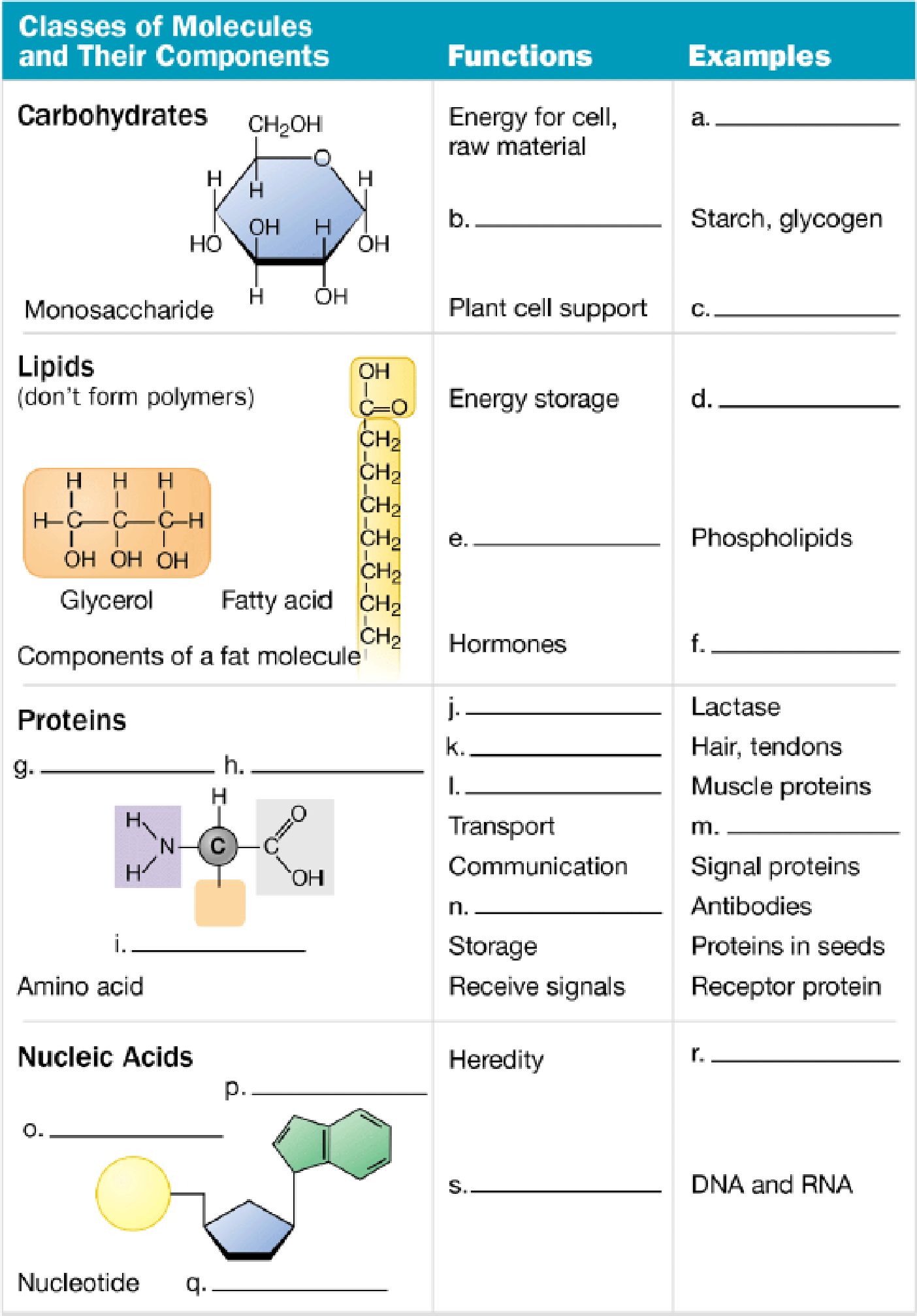
Concept explainers
Complete the following table to help you review the structures and functions of the four classes of organic molecules.

To create: The concept map to review the structures and functions of the four classes of organic molecules.
Introduction: The four classes of molecules such as carbohydrates, lipids, proteins, and nucleic acids are important to sustain the life. Carbohydrates serve as a fuel and building material for cellsand tissues. Lipid comprises a diverse group of molecules. It does not mix with water. A protein is a polymer of amino acids. It is structurally and functionally most complex and varied. Nucleic acid is the genetic material that consists of a polynucleotide.
Answer to Problem 1CC
Pictorial representation: Fig. 1 shows the completed concept map of structures and functions of the four classes of organic molecules.

Fig.1: Concept map of the structures and functions of the four classes of organic molecules.
Explanation of Solution
a.
Correct answer: Glucose
Explanation: Glucose is the raw material from which cell will get energy. Hence, the correct answer is Glucose.
b.
Correct answer: Energy storage
Explanation: The starch and glycogen is used as storage material of energy. Hence, the correct answer is energy storage.
c.
Correct answer: Cellulose
Explanation: Cellulose is polysaccharides which is a polymer of glucose molecule. Hence, the correct answer is cellulose.
d.
Correct answer: Fats
Explanation: Fats are a type of lipid. It is composed of glycerol and fatty acids. Hence, the correct answer is fats.
e.
Correct answer: Cell membrane component
Explanation: Cell is the outermost boundary of animal cell. It is made of phospholipid bilayer. Hence, the correct answer is cell membrane component.
f.
Correct answer: Steroids
Explanation: Steroids are hormones such as estrogen. Hence, the correct answer is steroids.
g.
Correct answer: Amino group
Explanation: Protein is made of amino acids. An amino acid contains amino group which is
h.
Correct answer: Carboxylic group
Explanation: Protein is made of amino acids. An amino acid contains carboxylic group which is
i.
Correct answer: R group
Explanation: Protein is made of amino acids. An amino acid contains a side group which is called R group. Hence, the correct answer is R group.
j.
Correct answer: Enzyme
Explanation: Proteins have broad functions such as enzymes, structural proteins, transport, movement, defense, and storage. Lactase is an enzyme used for breakdown of lactose molecule. Hence, the correct answer is Enzyme.
k.
Correct answer: Structural proteins
Explanation: Proteins have broad functions such as enzymes, structural proteins, transport, movement, defense, and storage. Hair and tendons are structural proteins. Hence, the correct answer is structural proteins.
l.
Correct answer: Movement
Explanation: Muscle is a protein that helps in movement. Hence, the correct answer is movement.
m.
Correct answer: Membrane transport protein
Explanation: Membrane transport protein helps in transport of different molecules across the membrane. Hence, the correct answer is Membrane transport protein.
n.
Correct answer: Defense
Explanation: Signal protein helps in communication. Antibodies are immunoglobulin protein that helps in body defense. Hence, the correct answer is defense.
o.
Correct answer: Phosphate group
Explanation: Nucleic acid is a polymer of nucleotides. A nucleotide consists of phosphate group, sugar and nitrogenous base. Hence, the correct answer is phosphate group.
p.
Correct answer: Nitrogenous base
Explanation: Nucleic acid is a polymer of nucleotides. A nucleotide consists of phosphate group, sugar and nitrogenous base. Hence, the correct answer is nitrogenous base.
q.
Correct answer: Ribose or deoxyribose
Explanation: Nucleic acid is a polymer of nucleotides. A nucleotide consists of phosphate group, sugar (ribose or deoxyribose) and nitrogenous base. Hence, the correct answer is ribose or deoxyribose.
r.
Correct answer: DNA
Explanation: Nucleic acid is a polymer of nucleotides. DNA (deoxyribonucleic acid) is the hereditary material. Hence, the correct answer is DNA.
s.
Correct answer: Code for protein
Explanation: Nucleic acid is a polymer of nucleotides. DNA and RNA have information to code for protein. Hence, the correct answer is code for protein.
Want to see more full solutions like this?
Chapter 3 Solutions
CAMPBELL BIOLOGY - BIO 121 W/ACC >IC<
- Choose from the columns the compound that correctly represents the functional groups listed (rows). Structure of compounds are shown below.arrow_forwardExamine the water molecule in figure 2.14 of the textbook . What type of bond occurs between each hydrogen and the oxygenarrow_forwardPlace the following components in order from least to most complex (atom, proton, starch, glucose, hydroxyl grouparrow_forward
- Define the following terms: a. hydrocarbon b. hydrophilic c. hydrophobic d. functional group e. R grouparrow_forwardDefine the following terms: a. carbonyl group b. carboxyl group c. amino group d. hydroxyl group e. peptide bondarrow_forwardOf the organic molecules listed below, which group has the greatest variety of three-dimensional shapes? fatty acids DNA phospholipids carbohydrates proteinsarrow_forward
- Explain this statement: “All compounds are molecules, but not allmolecules are compounds.” Give an example.arrow_forwardcan I get more explanation on organic chemistry of biological macromoleculesarrow_forwardUse this site to answer the question: https://www.echalk.co.uk/3Dmolecules/carbohydrates/glucoseOpen.htm What happens to your molecular formula when you create disaccharides? Why?arrow_forward
- Define the following terms: a. metalloprotein b. primary structure c. secondary structure d. tertiary structure e. quaternary structurearrow_forwardCreate a flowchart to show the similarities and differences between the 3 major categories of carbohydrates (starch, cellulose, and glycogen.arrow_forwardMatch the molecules with the best description.arrow_forward
 Human Biology (MindTap Course List)BiologyISBN:9781305112100Author:Cecie Starr, Beverly McMillanPublisher:Cengage Learning
Human Biology (MindTap Course List)BiologyISBN:9781305112100Author:Cecie Starr, Beverly McMillanPublisher:Cengage Learning Concepts of BiologyBiologyISBN:9781938168116Author:Samantha Fowler, Rebecca Roush, James WisePublisher:OpenStax College
Concepts of BiologyBiologyISBN:9781938168116Author:Samantha Fowler, Rebecca Roush, James WisePublisher:OpenStax College Biology Today and Tomorrow without Physiology (Mi...BiologyISBN:9781305117396Author:Cecie Starr, Christine Evers, Lisa StarrPublisher:Cengage Learning
Biology Today and Tomorrow without Physiology (Mi...BiologyISBN:9781305117396Author:Cecie Starr, Christine Evers, Lisa StarrPublisher:Cengage Learning



